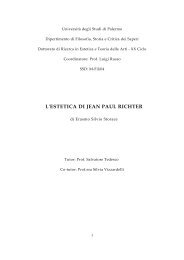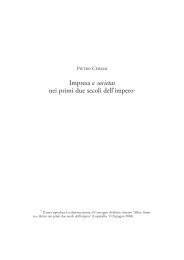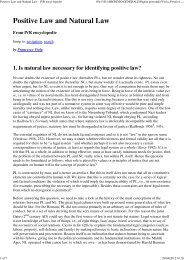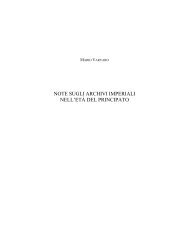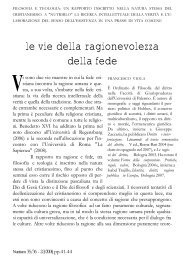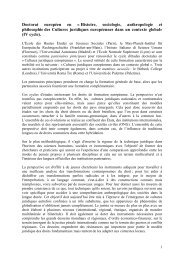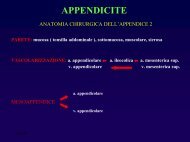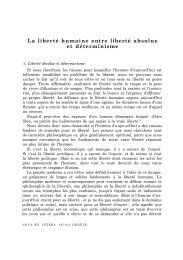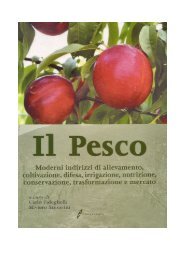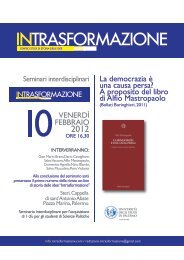M. VARVARO, Gai 4.163 e la struttura della formula arbitraria nell ...
M. VARVARO, Gai 4.163 e la struttura della formula arbitraria nell ...
M. VARVARO, Gai 4.163 e la struttura della formula arbitraria nell ...
Create successful ePaper yourself
Turn your PDF publications into a flip-book with our unique Google optimized e-Paper software.
M. Varvaro, <strong>Gai</strong> <strong>4.163</strong> e <strong>la</strong> <strong>struttura</strong> del<strong>la</strong> formu<strong>la</strong> <strong>arbitraria</strong> [p. 705-734]<br />
accertare se fosse stato compiuto qualcosa contro l’ordine contenuto<br />
<strong>nell</strong>’interdetto emanato dal magistrato, inoltre, risulta dal<strong>la</strong> lettura di<br />
<strong>Gai</strong> 4.141 [KRUEGER-STUDEMUND 7 , 191]: Nec tamen cum quid<br />
iusserit fieri aut fieri prohibuerit, statim peractum est negotium, sed ad<br />
iudicem recuperatoresue itur et ibi editis formulis quaeritur, an aliquid<br />
aduersus praetoris edictum factum sit, uel an factum non sit, quod is fieri<br />
iusserit. et modo cum poena agitur, modo sine poena: cum poena, ueluti<br />
cum per sponsionem agitur, sine poena, ueluti cum arbiter petitur rell.<br />
Nel brano appena trascritto si ricorda che, in seguito all’emissione<br />
dell’ordine di fare o di non fare che era oggetto dell’interdetto, si poteva<br />
procedere ad accertare, una volta effettuata l’editio delle formu<strong>la</strong>e,<br />
se fosse stato compiuto o meno qualcosa contro quanto stabilito dal<br />
pretore. 55 Immediatamente dopo si aggiunge che si agiva ora cum<br />
poena, ora sine poena. Poiché prima dell’indicazione di questa duplice<br />
possibilità il discorso è condotto chiaramente in una prospettiva<br />
unitaria, se ne può dedurre che tutte le formule alle quali si allude,<br />
compresa quel<strong>la</strong> impiegata <strong>nell</strong>’agere sine poena, dovevano avere un<br />
programma di giudizio che avrebbe imposto all’organo giudicante –<br />
giudice unico o recuperatores 56 – di effettuare tale accertamento.<br />
—————————<br />
55 Sul<strong>la</strong> questione che riguarda <strong>la</strong> presenza, in questo passo gaiano, del termine<br />
edictum in luogo di interdictum v., per tutti, A. BISCARDI, La tute<strong>la</strong> interdittale, cit. (nt. 3),<br />
64 s. Contro l’idea di W.B. LEIST, Die Bonorum possessio, I, cit. (nt. 3), 340 s., nt. 1,<br />
secondo cui il termine ‘edictum ’ del passo gaiano deriverebbe da una corruzione di<br />
interdictum, che sarebbe stato originariamente abbreviato in ‘tdictum ’, v. K.A. SCHMIDT,<br />
Das Interdiktenverfahren, cit. (nt. 3), 241, nt. 8, e A. UBBELOHDE, in F. GLÜCK, Commentario,<br />
XLIII-XLIV, cit. (nt. 3), 463-466. Dal punto di vista paleografico va notato<br />
che, a differenza di quanto sostenuto da Reinach in <strong>Gai</strong>us, Institutes. Texte établi et traduit<br />
par Julien Reinach Conseiller d’État, Paris 1950, 175 s., nt. 1, proprio dall’esame del<strong>la</strong><br />
riproduzione fotografica in bianco e nero del verso del folium singu<strong>la</strong>re de praescriptionibus<br />
et interdictis pubblicata in calce all’apografo di Studemund risulta chiaramente<br />
che, come esattamente riprodotto da G. STUDEMUND, Apographum, cit. (nt. 31), 236,<br />
al<strong>la</strong> fine del rigo 9 dopo le lettere ‘ ’ si legge chiaramente una ‘ ’, e non un segno<br />
abbreviativo rappresentato da una ‘ ’ da sciogliere in ‘inter ’. Per questa ragione, come già<br />
correttamente rilevato da H.L.W. NELSON, Überlieferung, Aufbau und Stil von <strong>Gai</strong> Institutiones,<br />
Leiden 1981, 10, nt. 24, non si può seguire J. REINACH, Introduction, in <strong>Gai</strong>us<br />
Institutes, cit. (supra ), XIII, quando sostiene che proprio questo sarebbe un grave errore di<br />
lettura da parte di Studemund.<br />
56 Come rilevato da K.A. SCHMIDT, Das Interdiktenverfahren, cit. (nt. 3), 252, in ciò<br />
726 AUPA 55/2012



